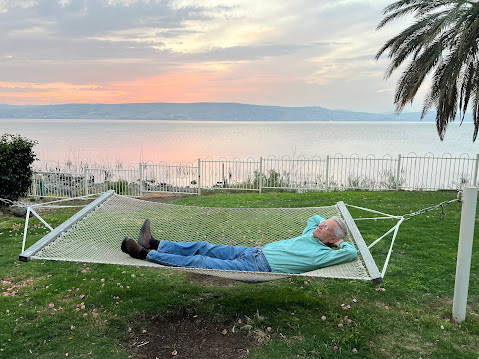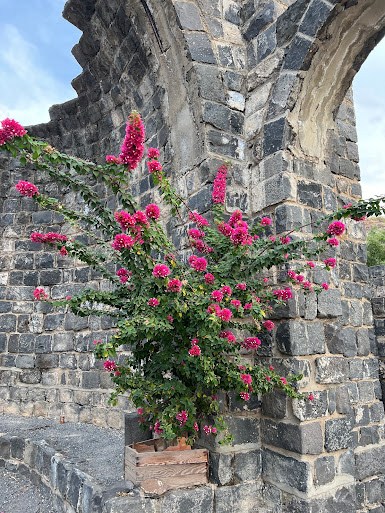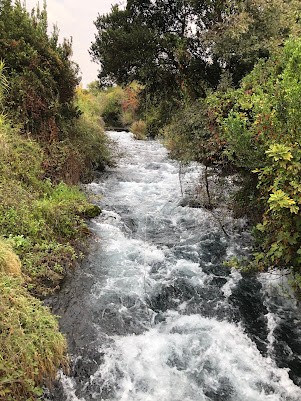Patty and Deanne went shopping in the Old City (and had a great time without the men), and Paul and Jim walked to the Old City, entering at Lion’s Gate, and explored the excavated area under the Sisters of Notre Dame de Sion convent, which is right by Hadrian’s Arch, also known as the Ecce Homo arch. This area is described in John 19:5: “Jesus came out, wearing the crown of thorns and the purple robe. Pilate said to them, ‘Behold the man.” Underground there are an amazing cistern, canals, and a Roman pavement. There is a place in the street pavement with a game carved into it, possibly a place where the Roman soldiers might have thrown dice for Jesus’s garment. John 19:24: “They said therefore among themselves, Let us not rend it, but cast lots for it, whose it shall be: that the scripture might be fulfilled, which saith, They parted my raiment among them, and for my vesture they did cast lots.” We went into the church and saw the organ high up in the loft.



We continued up the street a few yards to The Prison of Jesus, another interesting set of caves in a grotto-type area. It was actually quite impressive, even if it’s just a traditional site. There was a cell for Barabbas, and according to this site's tradition, the cell for Jesus had a stone table with two holes in it for his legs, as depicted in the mosaic above. It was an interesting Sunday walk.
But then the adventure began! Monday, we departed at 9:30 a.m. for Galilee. Stopped at the traditional baptismal site of Jesus near Jericho so Deanne could see it. Some pilgrims come to be baptized by immersion, but we also saw a group of Mexican pilgrims standing ankle-deep in the Jordan River, and then being sprinkled.
Then on up to Ein Gev, which is on the east side of the Sea of Galilee. We had our own 1-bedroom apartment right on the lake, with a nice view. We had lunch with all the students when we got there, very tasty, lots of fresh choices.
While the students went off to a canoe splash trip on the Jordan River, we drove up to Kursi, the traditional site of the miracle of the swine mentioned in Luke 8 and Matthew 8. This is also the site of the largest known Byzantine monastery in the Holy Land. Beautiful mosaics, arches, and columns. This and a small church on the hillside are probably from the 5th century AD.
We enjoyed the sunset over the Sea of Galilee and had a fantastic dinner in the resort dining room. Let's hear it for buffets!
On Tuesday we joined the students for a full-day field trip to Upper Galilee, places that we had never been to on previous trips. First was Tel Hazor, an important Canaanite city from the early Bronze Age. From 1800-1200 BC, it was the largest city in all of Canaan, and much yet to be excavated. One of the most interesting features was the water system, dug deep inside the city to provide water--another marvel of engineering.
Mauro Properzi, Jo Ann and Dave Seely (faculty)
Tel Dan was a huge surprise—green, lush, with rushing springs and rivers that feed the Jordan River. This was the traditional northern boundary of ancient Israel: “from Dan to Beersheba.”
Caesarea Philippi was another beautiful surprise, with more springs and rivers at the base of Mount Hermon. Here during the Hellenistic period (200 BC), the Seleucids carved niches in the cliff-face next to a cave for the worship of the Greek god Pan. And it was here that Jesus brought disciples (Mark 8:27, Matt 16:13, Luke 9:18). Somewhere nearby Jesus asked, “Whom say ye that I am?” and Peter testified, “Thou art the Christ, the Son of the living God.”
A real thrill was the visit to Nimrod’s Fortress, a castle built in the 13th century by the Ayyubids, reinforced by the Mamluks to defend against the Crusaders, conquered by the Mongols, etc. Extensive rock work, arches, cisterns, and lookouts over the countryside. We all had a great time exploring this sensational castle.
A cistern, not a putting green!
Our last stop was Har Bental, an overlook in the northern Golan Heights. From this vantage point, we could see the ancient road to Damascus, and it was somewhere in the area that the Lord Jesus appeared to Saul (Acts 9:2-6), after which Paul became the greatest missionary of the early Church. But this overlook was also important in the wars between Israel and Syria (which this spot borders). The leftover bunkers and batteries are a grim reminder of what took place there during the Six Day War in 1967 and at other times.
With Frank Judd and Jo Ann and Dave Seely
On Wednesday, our first stop was the ancient city of Akko (later called Acre) on the coast, just north of Haifa. This place has so much history, but we spent most of our time exploring the Citadel or Knights’ Hall and all the Crusader history. Much of the excavations are now underground but of course were above ground when they were originally built. We also walked through the Templar Tunnel, 350 meters long and carved into bedrock, leading from the Citadel to the Coast. We had a good Arab lunch near the bus station.
Aaron, Rachel, Gracee, Elisabeth, Sean, Maddie, Emma, Jonah
Sweet treats in the market
Then took off for Beit She’arim which has an important series of tombs, some of them from around 200 AD.
The highlight of the day was the visit to Sepphoris which is known for its amazing mosaics, including the depiction of a Nilometer (measuring the flow of the Nile River), people dancing to the music of Orpheus, the Mona Lisa of the Galilee, and most importantly the remains of a synagogue from the 5th century AD, depicting God’s promises and the importance of the temple.

"Mona Lisa of the Galilee"
Rainbow over Galilee
We also saw the Roman theater that had seats for 4500 people, constructed around 100 AD. We learned that the Greek word for actor is “hypocrite,” someone who plays a role when they are in front of others, but they act differently when off stage. Actors were introduced by trumpet as they walked on stage, and they exaggerated their facial expressions to entertain the audience. In the Sermon on the Mount, Jesus taught: “When thou doest thine alms, do not sound a trumpet before thee as the hypocrites do … that they may have glory of men … When ye fast, be not as the hypocrites, of a sad countenance: for they disfigure their faces, that they may appear unto men to fast.” Matt 6:2, 5.
Instead of following the buses to Haifa and Caesarea on the coast Thursday, we had a leisurely morning at En Gev, a late breakfast, and then left at 10:00 for Bet She’an, which is one of the greatest ancient sites in the world. Bet She’an’s history goes back to more than 1500 BC, but it was the Romans who conquered the city in 63 BC and made it the most important city in northern Israel. It features a magnificent 7,000-seat theater, elaborate bathhouse, long colonnaded streets, and even a latrine with running water. The tel overlooking the city provides a commanding view, and also has what is known as the Judas Tree, a traditional site of his hanging, which has been featured in movies. You could spend all day exploring this ancient city.
pillar graveyard
The Judas Tree
We then drove back to Jerusalem where we got busy catching up on a lot of work. It was quite a week. 5-6 miles walking each day! Beautiful weather. Nice group to hang out with. Hard to believe it will only be 3-1/2 more weeks until these students go home. The Christmas Concert is coming right along. We have 54 strong voices and a lot of energy in the choir. We are really lucky.



























































Another blog filled with inspiration~! Blessings to you.
ReplyDeleteWe love your detailed commentary. You could write a guide book. Maybe you should. I remember a time when we were at Bet She'an and it was 114 degrees. It looks like it might have been a little cooler when you were there. It is an amazing ancient site that offers so much to see and explore.
ReplyDeleteAh, isn't Ein Gev fantastic!? Love those northern explorations. And I didn't know that about hypocrite, interesting!
ReplyDelete